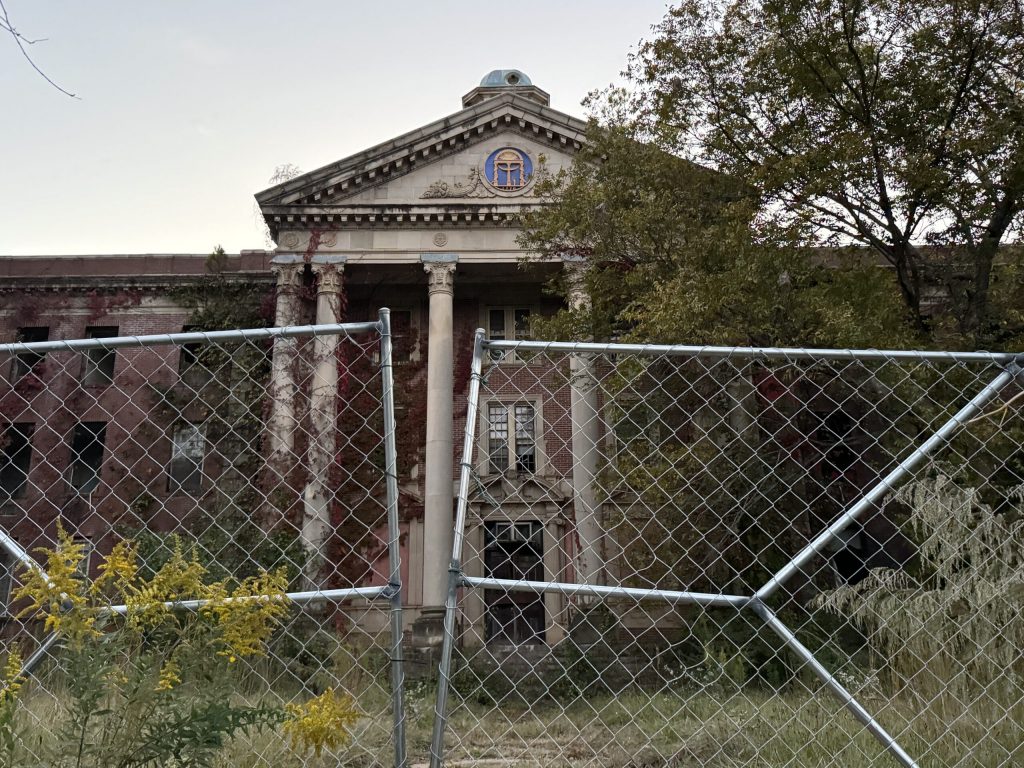Brick and mortar reminders of Georgia’s mistreatment of psychiatric patients could be erased soon

The Jones building at Central State. Jill Nolin/Georgia Recorder
Thousands of Georgians were once confined to the world’s largest mental institution, authorized by the state in 1837 as the “Lunatic, Idiot, and Epileptic Asylum.” The Milledgeville asylum’s miserable conditions were infamous with practices of the time like lobotomy and electroshock therapy as well as primitive tactics like metal cages, straitjackets and involuntary sterilizations.
The nearly 13,000 patients were served by just 48 “doctors,” some of whom were patients at the asylum themselves. In 2007, 42 suspicious deaths at the asylum, which had been downsized and renamed Central State Hospital, spurred a U.S. Department of Justice investigation, and by 2010, the state announced that most of the asylum would be closed for good.
But now, the state is demolishing three prominent buildings at Central State Hospital – and wiping away some of the brick-and-mortar testament to the darker side of Georgia’s history. In July, Gov. Brian Kemp issued an executive order allowing the state Department of Behavioral Health and Developmental Disabilities to demolish three main buildings that sit on what is known as the campus’ pecan grove: Walker, Green and Jones. The iconic Powell building, which was the original building, would be left untouched.
The planned demolition has prompted outcry from historic preservationists and local citizens, who argue with the local authority charged with transforming the property and the state agency’s plan to demolish the buildings. Preservationists argue that the hospital’s historical significance is too valuable to be destroyed.
While there is no set date for demolition, conversations about the hospital’s future, which have continued for more than 10 years, remain ongoing.
On Oct. 26, DBHDD sent an initial submittal to the Georgia Department of Community Affairs Historic Preservation Division for consultation on the demolition, according to Jennifer Dixon, the division’s director. The state agency is expected to respond to the agency’s consultant by Nov. 22 and while not typically required to conduct site visits, did conduct one for the Central State Hospital property.

The Green building at Central State. Jill Nolin/Georgia Recorder
Back in 2010, the state established the Central State Redevelopment Authority, which was tasked with creating an initiative to repurpose some of the buildings for jobs and tax revenue that was eventually named “Renaissance Park.” The redevelopment authority has brokered several commercial deals on some of the buildings, but has not taken control of all the buildings or the three currently in contention.
Unofficial historian of the hospital and founder of the preservationist group Friends of Central State Hospital, Edwin Atkins said that the Renaissance Park rebranding was the first indication he remembers that the property would likely be up for future demolition.
“They want to get rid of the bad image of Central State Hospital, so they changed the name to Renaissance Park, a rebirth, something new, and they want to get rid of all the old buildings,” Atkins said.
The state had a contract with Baldwin County to provide fire services for the hospital, but conflicts over that agreement resulted in the county filing a lawsuit against DBHDD in 2021.
“If you’re going to look at a catalyst for demolition, it would probably be the lawsuits that Baldwin County brought against the state,” Chairman of the Central State Hospital Local Redevelopment Authority Johnny Grant said. Part of the Baldwin County lawsuit addressed the hospital’s deterioration that presented a fire hazard and increased liability for the state.
A few years ago, Grant said, a company out of Florida also showed interest in the property the hospital is located on. They eventually pulled out because they did not have the money to demolish the buildings – a problem that would make most projects on the Milledgeville property economically unfeasible, Grant said. If cleared, “the space would be more attractive, less dangerous, and more conducive to finding some future purpose,” he said.
Grant and Mike Couch, the previous executive director of the redevelopment authority, agree that the demolition allows for greater economic opportunity in Milledgeville. “We did something that’s never been done in the state of Georgia before – we quantified the value of real estate as something other than dollars. It becomes the value of jobs, the value of property tax inducement,” Couch said.
The set up of the redevelopment authority allows property to be transferred from the state to the redevelopment authority for economic development purposes, Grant explained, noting that the redevelopment authority declined an offer for the bulk of the hospital property, including the three buildings and many more, because of an inability to maintain them or deal with the buildings’ liability. Instead, the hospital property remained in the hands of the state.
Several controversies riddled the lead up to the demolition executive order. A year ago, an asbestos abatement at the hospital prompted criticism after DBHDD, which had not gotten demolition approval, characterized the work as a safety issue unrelated to demolition. The Saporta Report later reported that DBHDD had a list of buildings targeted for demolition after reviewing the contractor documents.
“The state began work on abating asbestos a little more than a year ago, and it was made known at the time that discussions were underway about how to mitigate the very real safety risks those properties present,” said Ashley Fielding, assistant commissioner of agency affairs with DBHDD.
The Saporta Report also reported that DBHDD’s numbers for the cost of preservation were made after a single undocumented phone call with an unnamed architect. Their open records request for all documents pertaining to the demolition decision yielded no evidence of historic preservation alternatives or consultations about cost. A DBHDD official later told the online news outlet that the preservation analysis was based on the undocumented phone call. Fielding told the Georgia Recorder that the agency’s staff talked to an architect who gave them some estimates about the cost.
“They didn’t even have a name, so they had no accurate figures of what it was going to cost to save a building,” Atkins said. “That means that the governor didn’t have an accurate [amount] because when they got the governor to sign the executive order to take them down, I’m sure they told him those same amounts, which were totally false.”
DBHDD officials say it is not in the agency’s budget or purpose to save the hospital buildings. Its nearly $1.6 billion budget is almost entirely designated to serving individuals with mental illness, substance use disorder and intellectual and developmental disabilities, Fielding said. The buildings also pose a public safety liability.

The Walker building at Central State. Jill Nolin/Georgia Recorder
“Trespassing on these properties presents a significant risk to these individuals in terms of their safety and their lives, and as the owners of these buildings, the state has to protect against those very serious risks,” Fielding added.
As conversations between state officials and preservationists continue, the fate of Central State Hospital hangs in the balance.
The Georgia Trust for Historic Preservation and others opposed to demolition are asking the state for more time to find a way to salvage the buildings and for proof that the agency has put a fair effort into preservation.
Ben Sutton, director of preservation with The Georgia Trust, noted that each of the buildings are great examples of particular historical architectures that provide “a much higher level of significance that would be lost if individual buildings were torn down,” and, of course, the importance of Central State Hospital in 19th and 20th Georgia and United States history.
“That is a history that means different things to different folks,” Sutton said. “But it’s important to remember that history and to remember that part of Georgia’s history.”
SUPPORT NEWS YOU TRUST.
The post Brick and mortar reminders of Georgia’s mistreatment of psychiatric patients could be erased soon appeared first on Georgia Recorder.




